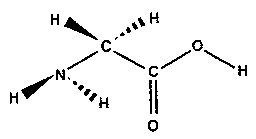 |
Science Frontiers ONLINE No. 95: Sep-Oct 1994 |
|
|
It's according to hoyle and wickramasinghe
The June 17, 1994 issue of Science did not ignore it. In fact, this conservative journal devoted almost an entire page to a paper presented by Yi-Jehng Kuan and Yanti Miao at the recent Minneapolis meeting of the American Astronomical Society. Students of L. Snyder, at the University of Illinois, Kuan and Miao reported that the amino acid glycine had been detected in a molecular cloud named Sagittarius B2. Glycine has only ten atoms and is the smallest of the 20 amino acids vital to life-as-we-know-it. The Science article supposed that this discovery of extraterrestrial glycine might reignite speculation that earth life might not be unique after all.
(Travis, John; "Hints of First Amino Acid outside Solar System," Science, 264:1669, 1994.)
 Structure of the amino acid glycine |
"He believes it is only a matter of time before other amino acids, together with nucleotide bases, the components of nucleic acids that make up genetic material, are found in space. 'This is just the tip of the iceberg,' he says. 'I would fully expect a vast array of life molecules to be discovered in space, and then there would be no doubt as to where terrestrial life began.'"
(Hecht, Jeff; "'Molecule of Life' Is Found in Space," New Scientist, p. 4, June 11, 1994.)
Comment. Here is a case where a scientific prediction was made, but its author labelled heretical. It is a scientific victory, but we guess that Hoyle and Wickramasinghe are too iconoclastic for Science to give them credit for their prediction.